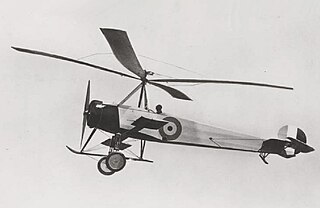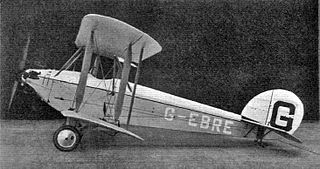
The Avro 691 Lancastrian was a British and Canadian passenger and mail transport aircraft of the 1940s and 1950s developed from the Avro Lancaster heavy bomber. The Lancastrian was basically a modified Lancaster bomber without armour or armament and with the gun turrets replaced by streamlined metal fairings, including a new nose section. The initial batch was converted directly from Lancasters; later batches were new builds.

The Mil Mi-34 is a light helicopter designed by the Mil Moscow Helicopter Plant in either a two or four seat configuration for utility and training. It was first flown on 17 November 1986 and introduced at the Paris Air Show in 1987. The Mi-34 entered production in 1993, and is capable of performing aerobatic manoeuvres, including rolls and loops.

The Cierva C.30 is an autogyro designed by Juan de la Cierva and built under licence from the Cierva Autogiro Company by A V Roe & Co Ltd (Avro), Lioré-et-Olivier and Focke-Wulf.

The Cierva C.6 was the sixth autogyro designed by engineer Juan de la Cierva, and the first one to travel a "major" distance. Cierva, the engineer responsible for the invention of the autogyro, had spent all his funds on the research and creation of his first five prototypes. Therefore, in 1923, he turned to the Cuatro Vientos Aerodynamics Laboratory chief, Commander Emilio Herrera, who succeeded in persuading General Francisco Echagüe, the director of the Military Aviation Aeronautics Department, to take over the second stage in the research and development of Cierva's autogyros.

The Auster J/4 was a 1940s British single-engined two-seat high-wing touring monoplane built by Auster Aircraft Limited at Rearsby, Leicestershire.
The Aerospace General Mini-Copter was a miniature helicopter designed to be air-dropped to U.S. military pilots stranded behind enemy lines or in otherwise inaccessible areas.

The Albatros L 75 Ass was a German trainer biplane of the 1920s. Of conventional configuration, it seated the pilot and instructor in separate, open cockpits. The wings were single-bay, equal-span, and had a slight stagger. Production continued after Albatros was absorbed by Focke-Wulf.

The Cierva W.11 Air Horse was a helicopter developed by the Cierva Autogiro Company in the United Kingdom during the mid-1940s. The largest helicopter in the world at the time of its debut, the Air Horse was unusual for using three rotors mounted on outriggers, and driven by a single engine mounted inside the fuselage.

The Avro Avian is a series of British light aircraft designed and built by Avro in the 1920s and 1930s. While the various versions of the Avian were sound aircraft, they were comprehensively outsold by the de Havilland Moth and its descendants.

The Avro Club Cadet was a 1930s single-engined British biplane trainer aircraft, designed and built by Avro as a development of the earlier Cadet. It was planned for private and club use and, unlike the Cadet, was fitted with folding wings.

The Avro 701 Athena is a British advanced trainer aircraft built by Avro in the late 1940s. It was designed to replace the North American Harvard in the Royal Air Force, but was bought only in small numbers, the competing Boulton Paul Balliol being preferred.

The Avro 534 Baby was a British single-seat light sporting biplane built shortly after the First World War.

The Blackburn L.1 Bluebird was a British single-engine biplane light trainer/tourer with side-by-side seating, built in small numbers by Blackburn Aircraft in the 1920s.

The Cierva C.8 was an experimental autogyro built by Juan de la Cierva in England in 1926 in association with Avro. Like Cierva's earlier autogyros, the C.8s were based on existing fixed-wing aircraft fuselages – in this case, the Avro 552.

The Cierva C.19 was a 1930s British two-seat autogyro, designed by Spanish engineer Juan de la Cierva. It was built by Avro as the Avro Type 620. It proved to be the most successful and widely produced of the early de la Cierva designs.

The Reid Rambler, later known under the Curtiss-Reid brand after Reid was purchased by Curtiss, was a biplane trainer/sport aircraft built in Canada in the early 1930s and used in small numbers as a trainer aircraft by the Royal Canadian Air Force.

The ADC Cirrus is a series of British aero engines manufactured using surplus Renault parts by the Aircraft Disposal Company (ADC) in the 1920s.

The Pitcairn PA-34 and Pitcairn PA-33, given the United States Navy (USN) designation Pitcairn OP-2 and United States Army designation Pitcairn YG-2 respectively were reconnaissance autogyros designed and built in 1936 for evaluation.

The Macchi M.53 was an Italian reconnaissance floatplane designed and built in the late 1920s by Macchi for the Regia Marina.
The Cierva C.29 was a five-seat British cabin autogyro built in 1934 as a joint venture between Westland Aircraft and Cierva. The rotor system and rotors were designed by Cierva and the fuselage by Westland. It was powered by a 600 hp (447 kW) Armstrong Siddeley Panther II engine with a two-bladed tractor propeller; the engine also drove the three-bladed rotor via a clutched shaft. The C.29 suffered from ground resonance during ground running and was not flown. It was later acquired for evaluation by the Royal Aircraft Establishment but it was unable to cure the resonance problem and the autogyro was scrapped in 1939.



















